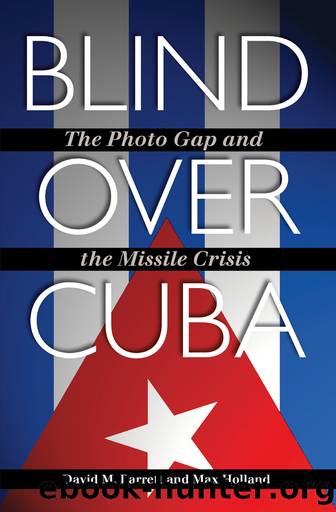Blind over Cuba by Barrett David M.;Holland Max;

Author:Barrett, David M.;Holland, Max;
Language: eng
Format: epub
Publisher: Texas A&M University Press
Published: 2012-08-15T00:00:00+00:00
Appendix
A Historiography of the Photo Gap, 1963â2011
Speculation about an âintelligenceâ or âphotoâ gap began to mount as soon as the acute phase of the crisis peaked in October. Chapter 1 addressed media coverage of this issue for the remaining months of 1962. This historiography traces the presentation and interpretation of key facts in the public and classified literature, and the varying interpretations given the collection deficit, beginning in 1963 and thereafter. As will be seen, the deficit remained a matter of great confusion in the public literature for decades and even, to some degree, in the classified literature.
The first partly accurate explanation appeared as early as March 1963 in a story by Jules Witcover, the Pentagon beat reporter for the Newhouse Newspapersâ Washington bureau. The account as published in the Washington Star missed some important details. Still, Witcover managed to convey the genuine reason for the intelligence deficit.1 The major omission in the story was that it made no mention of the pivotal meeting in McGeorge Bundyâs office on September 10, 1962, that resulted in attenuation of U-2 surveillance.
Despite its accuracy, Witcoverâs account had little impact.2 Other reporters and columnists continued to put forward the administrationâs proffered explanation or simply muddled the issue, which served the same end. More importantly, two months later the Senate Preparedness Investigating Subcommittee, chaired by John Stennis, released its report, which flatly declared that allegations about a photo gap were âunfounded.â3 This influential finding became the dominant one. As a consequence, it would not be understood for at least a decade that the run-up to the missile crisis was, in fact, a near failure of the first magnitude.4 The Kennedy administrationâs initial obfuscation of the issue remained so successful that scholarly consensus on this point never achieved unanimity.
The First Publications: 1960s
The first book published about the missile crisis appeared in August 1963, written by Henry M. Pachter, a German émigré and professor of history. He had sent dispatches to European papers the previous October, writing stories about the crisis from the perspective of the United Nations Security Council. He relied upon public documents, interviews with diplomatic sources âwho prefer[red] to remain anonymous,â and government information officers. According to Pachter, McCone âordered weekly surveillanceâ of Cuba after the SA-2s were discovered, and U-2 sorties were planned for September 5, 17, 26, and 29 and October 7. But U-2 incidents over Soviet and Chinese airspace thwarted McConeâs plans, and all U-2 flights were canceled on September 4. At the end of September U-2 surveillance resumed, Pachter wrote, âsince the risk of an incident now seemed of lesser consequence than the risk of ignoring what was going on.â The missiles were not discovered until October 14 because unfavorable weather conditions forced a delay.5
In an intriguing footnote, Pachter wrote that administration sources âhave vaguely hinted that . . . reconnaissance flights during September were limited to âsideways approachesâ outside territorial waters or may not have involved U-2 planes. Another story says that the pilots did not find the places
Download
This site does not store any files on its server. We only index and link to content provided by other sites. Please contact the content providers to delete copyright contents if any and email us, we'll remove relevant links or contents immediately.
| Antigua | Bahamas |
| Barbados | Cuba |
| Dominica | Dominican Republic |
| Grenada | Haiti |
| Jamaica | Saint Kitts |
| Saint Lucia | Saint Vincent |
| Trinidad and Tobago |
Cat's cradle by Kurt Vonnegut(13903)
Pimp by Iceberg Slim(12953)
Underground: A Human History of the Worlds Beneath Our Feet by Will Hunt(11274)
4 3 2 1: A Novel by Paul Auster(11078)
The Radium Girls by Kate Moore(10928)
American History Stories, Volume III (Yesterday's Classics) by Pratt Mara L(4830)
Perfect Rhythm by Jae(4630)
Wiseguy by Nicholas Pileggi(4606)
The Fire Next Time by James Baldwin(4356)
Paper Towns by Green John(4179)
A Higher Loyalty: Truth, Lies, and Leadership by James Comey(4044)
Pale Blue Dot by Carl Sagan(4021)
The Mayflower and the Pilgrims' New World by Nathaniel Philbrick(3922)
The Doomsday Machine by Daniel Ellsberg(3743)
Too Much and Not the Mood by Durga Chew-Bose(3702)
Killers of the Flower Moon: The Osage Murders and the Birth of the FBI by David Grann(3630)
The Borden Murders by Sarah Miller(3597)
The Sympathizer by Viet Thanh Nguyen(3528)
Killing England by Bill O'Reilly(3467)
